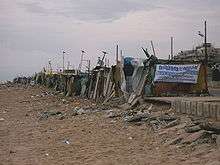Slums in Chennai
Chennai is the capital city of the South Indian state of Tamil Nadu and is the fourth largest metropolitan city in the country. A total of 29% of Chennai population resided in slums as of 2011. The state government of Tamil Nadu has established a Slum clearance Board, with a minister heading it.


Demographics
According to the 2011 slum population Survey of India, 31% of Chennaities were living in slums. It is second in the list among Mumbai (40%) and Kolkata (30%). The other big cities New Delhi had 15% and Bangalore had 9% people residing in the slums.[1]
As of the provisional population totals of 2001, the slums in Chennai 10,79,414 persons, which constituted 25.6% of the total population of the city. salem and Trichy had 23% and 19% of the population living in slums. Out of the totals in Chennai, 548,517 were males and rest were 530,897 females. The child sex ratio was 968 females to every 1,000 males compared to the non-slum sex-ratio of 945. The literacy rate of the slum population was 80.09% with 85.77% in males and 74.21% in females. There were a total of 125,725 households constituting 81,128 permanent (64.53%), 22,415 semi-permanent (17.83%) and 22,182 temporary households (17.64%). 66.96% of houses had single rooms, 24.19% had two, 5.85% had three and 2.17% had more than three rooms. There were totally 70,689 (56.23%) own houses, 50,764 (40.38%) rented houses and 4,272 (3.39%) other houses. Only 26% of the total population had access to water in the houses, while majority travel at least 500m to get drinking water. Handpumps and pipes are the major sources of water. There were 38,838 (30.89%) hand pumps, 53,556 (42.60%) water pipes, 3,162 (2.52%) tube wells, 4,665 wells and 25,062 (19.93%) other sources of water. Only 79.41% of the slum dwellers had access to electricity and 1,409 households had no access to lighting. Around 34% of the households had no latrines, resulting in spread of diseases. Around 43.87% households had radio while 60.07% households had televisions.[2]
Factors
The major factor contributing the development of slums is the lack of employment in rural areas and rapid urbanization in Chennai. People migrate from their hometown to Chennai and get employed in different unorganized sectors.[3]
Work
According to a study published in Society for Participatory Research in Asia and Indicus Analytics, the urban slums in metropolitan cities contribute to 7% of the Gross Domestic Product (GDP) of the country.[4]
Government policies
The Tamil Nadu government did not have any policy until 1971, though it had notified slums from the pre-independence period of 1932. The Tamil Nadu Slum Areas (Improvement & Clearance) Act of 1971 empowered the government to protect the rights of slum dwellers from eviction or relocation. The policy helped in created the Tamil Nadu Slum Clearance Board (TNSCB), which comes under the Department of Housing of the state government of Tamil Nadu. The government also had powers to demolish objectionable slums. Some of the slum development works of the government are externally funded by agencies like World Bank.[3]
Hazards
Most of the slums were single room houses and had poor living conditions. The room had to be used for all domestic purposes like cooking, sleeping and cleaning vessels. Most of the slums do not have drainage facilities and open toilets are widely used, resulting in spread of diseases.[3]
The Chennai MRTS completed in various phases between 1998 and 2004 had infrastructure issues as most of the path was located in slums. The station approach roads were also reported to be unsafe for commuters on account of slums and the threat of robbery.[5]
Retrieval
The government under its vision 2023 formulated the idea of building 10,000 flats in Kadambur area at a cost of ₹825 crores. It is planned to be a self-supporting residential structure with infrastructure facilities.[6]
References
- Johnson, Kay (22 March 2013). "Census: 1 in 6 India city residents lives in slums". New Delhi, India: AP Online. Archived from the original on 23 March 2015. Retrieved 5 October 2014. – via HighBeam (subscription required)
- Chandra, pp. 82-88
- Kumaran T., Vasantha; S. Divya, Rajeswari; N., Annammadevi; J., Nandhini; Bunch, Martin; Marley, David; Franklin, Beth (1 May 2012). "Community Engagement in Chennai Slums A Reflection from the Field". Internationales Asien Forum. International Quarterly for Asian Studies. Archived from the original on 23 March 2015. Retrieved 5 October 2014. Cite journal requires
|journal=(help) – via HighBeam (subscription required) - "Slums Contribute 7% to India's GDP, It's Time to Upgrade Them". The Hindustan Times. New Delhi, India. 18 October 2013. Retrieved 5 October 2014. – via Questia Online Library (subscription required)
- "Mass rejected transit system ; Chennai's MRTS carries just about 10 per cent of the commuters it was meant to, making it a case study in bad urban infrastructure planning. What can revive it?". Business Today. 4 April 2010. Archived from the original on 18 November 2018. Retrieved 11 January 2015. – via HighBeam (subscription required)
- "10,000 Flats in Chennai". Mena Report. 26 July 2014. Archived from the original on 7 March 2016. Retrieved 11 January 2015. – via HighBeam (subscription required)
External links
- Dr. C., Chandramouli (15–17 December 2003). "Slums In Chennai: A Profile" (PDF). Proceedings of the Third International Conference on Environment and Health. Department of Geography, University of Madras and Faculty of Environmental Studies, York University.